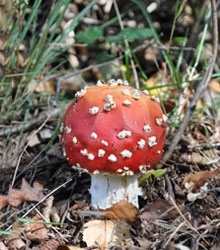Fly agaric (Amanita muscaria)
 There are more than 3,000 different types of mushrooms and toadstools in the UK and almost unbelievably, it is reckoned that a gram of woodland soil can contain more than a million microscopic fungi. But one of the best known of all these fungi, perhaps THE quintessential toadstool, is the bright red mushroom with white spots that is so often depicted alongside the garden gnome or fairy.
There are more than 3,000 different types of mushrooms and toadstools in the UK and almost unbelievably, it is reckoned that a gram of woodland soil can contain more than a million microscopic fungi. But one of the best known of all these fungi, perhaps THE quintessential toadstool, is the bright red mushroom with white spots that is so often depicted alongside the garden gnome or fairy.
This striking looking fungus is called the fly agaric and is a relatively common species that is most often found during the autumn months and is associated with certain tree species, especially birch and pine growing on acidic soils. By growing directly under a tree, fly agarics attach their minuscule hair-like roots onto the tree’s roots, so that they can draw off some of the nutrients collected by the tree. This does not seem to damage the tree in any way and once you have located a group of fly agaric, you should be able to return year after year to see them.
Because of its rather garish red appearance, many believe this toadstool to be deadly poisonous. Although it is indeed poisonous, if it is cooked, it reduces the poison’s effect so that can, in fact, be consumed. It does, however, have hallucinogenic properties, which amongst other symptoms can cause objects to appear distorted in size, often appearing much bigger than they really are. Rumours abound that it was this fantastical effect from eating such a toadstool which prompted Lewis Carroll to write Alice’s Adventures in Wonderland.
Another result of consuming this mushroom is that it can cause delirium and this is one possible explanations of why the word “fly” is part of the name, as it was considered in medieval times that some mental illness was caused by flies actually entering the human brain. The most likely reason, however, is that it was common practice to break up some of the fungus into a saucer of milk, which in turn was placed in the kitchen to attract flies, but also killed them when they drank the poisonous milk. I wouldn’t imagine that it did much for the health of the house cat either!
So, when you next go down to the woods, keep an eye out for these intriguing fungi, and if you see a gnome or fairy sitting on one, you might just remind them to take care, as the derivation of the word toadstool comes from the German word “toad-stuhl” meaning “seat of death”!
Peter Thompson
Advisory

Download Peter Thompson's essential 26-page book, featuring beautiful photography and detailed profiles of Britain's wildlife
Download FREE >